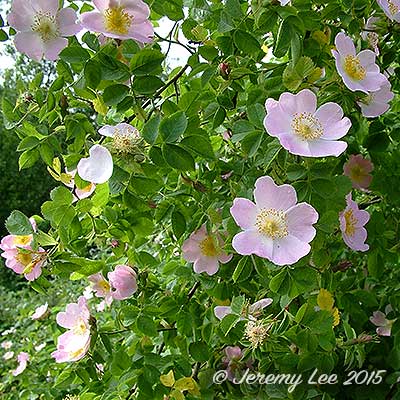
 |
|
Scientific Classifications explained » Amphibians » Ants » Aphids » Bees » Beetles » Birds » Bugs » Butterflies » Caterpillars » Damselflies » Dragonflies » Earwigs » Flies » Frog/Leafhoppers » Fungi » Galls » Grasshoppers » Harvestmen » Hoverflies » Lacewings » Ladybirds » Leaf Mines » Lichens » Mammals » Millipedes » Mosses » Moths » Sawflies » Slugs » Snails » Spiders » Trees & Shrubs » Wasps » Wild Flowers » Woodlice » Postboxes |
UK Nature > Wild Flowers > Red & Pink Wild Flowers > Rosa canina

Common Name: Dog Rose Scientific Name: Rosa canina Rosa canina, more commonly known as the Dog Rose, is the stylised rose of mediveval heraldry. Known in Shakespeare's time as eglantine, what this native rose lacks in scent it makes up for in blushing beauty. There are many species of wild dog rose, Rosa canina, which are all very similar and difficult to identify; they all have white or pink flowers, thorns and red hips in the winter. The deciduous Dog Rose has arching stems with curved thorns, blue-green leaves divided into five to seven hairless leaflets, and pink or white flowers (with five petals) often growing in clusters of two or three. It is a scrambling shrub, found in hedgerows, woodland edges, on sand dunes and grasslands. It is the most abundant of our native, wild roses, with sweet-scented pink or white flowers that appear in June and July. In the autumn, it produces bright red rosehips that are often eaten by birds and small mammals such as bank voles. |
|

https://www.uknature.co.uk is a website dedicated to showing the immense diversity of UK nature and wildlife. Our vast range of habitats, from lowland arable to snow covered mountains, from storm-ravaged coastlines to peaceful inland freshwater lakes and rivers, from dry, sandy heaths to deciduous and coniferous forests, all these habitats contribute to the abundance of UK nature. We have wild birds in huge numbers either residing or visiting our shores (597 recorded species as at July 2013) and we must also not forget the humble back garden with its grass lawns, flower beds filled with nectar rich flowers, shrubs and trees, all designed to attract huge numbers of insects such as bees, moths, butterflies and hoverflies; and finally the small ponds which provide safe havens for frogs, toads, newts and even slow worms and grass snakes. www.uknature.co.uk is the showcase for my personal passion, photographing uknature in all its glory. I sincerely hope you all enjoy the fruits of my labours. This site and all images contained therein is © Jeremy Lee 2004 - 2025. All Rights Reserved. Site design by Jeremy Lee. Site development & IT Support by Stuart Lee. |